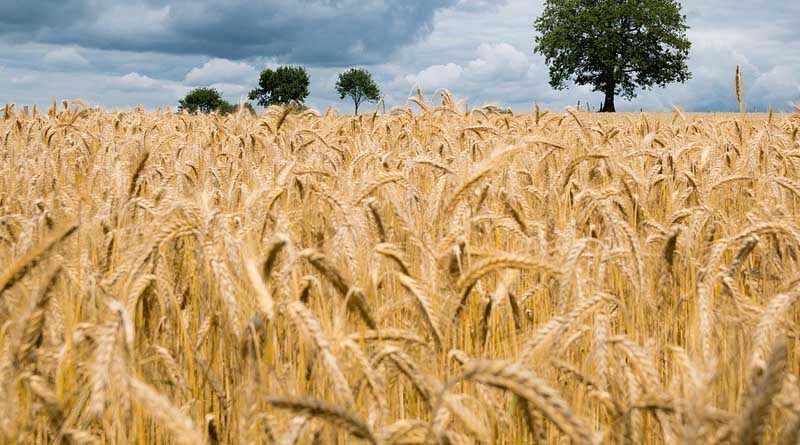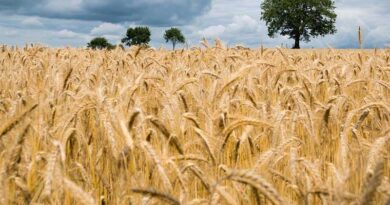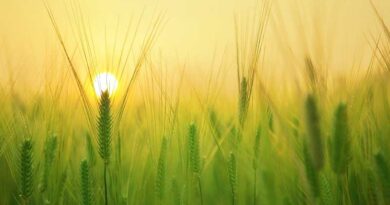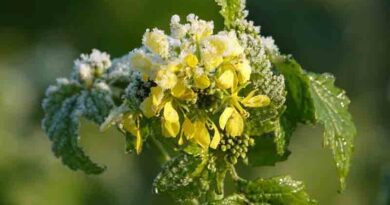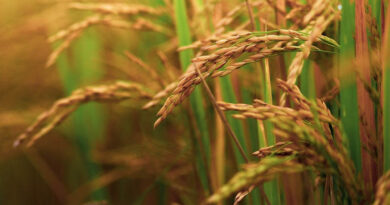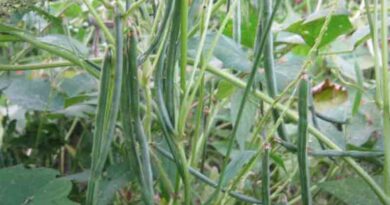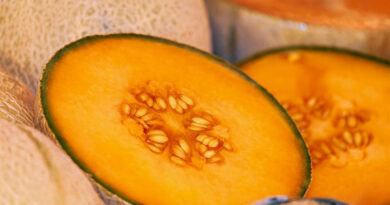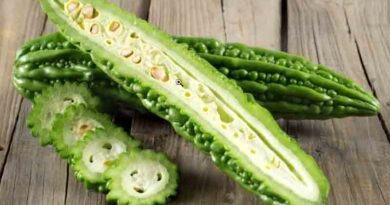10 new high yielding wheat varieties for Punjab, Haryana, Uttar Pradesh and Rajasthan
19 October 2022, New Delhi: Given below are 10 high yielding wheat varieties for Punjab, Haryana, Uttar Pradesh, Rajasthan, Delhi, parts of Uttarakhand, Himachal Pradesh and Jammu & Kashmir. These varieties have been released after various trials and are resistant to major diseases of wheat.
1. High yielding wheat variety DBW 296 (Karan Aishwarya)
DBW 296 (Karan Aishwarya) is a new high yielding bread wheat cultivar developed by ICAR-Indian Institute of Wheat and Barley Research, Karnal and has been released for North-Western Plains Zone (NWPZ) of India. NWPZ covers Punjab, Haryana, Delhi, Rajasthan (except Kota and Udaipur divisions), western Uttar Pradesh (except Jhansi division), parts of Jammu and Kashmir (Jammu and Kathua Distt.), parts of Himachal Pradesh (Una Distt. and Paonta Valley) and Uttarakhand (Tarai region).
This variety is found to be tolerant to drought stress.
Yield potential – 83.3 q/ha
Average yield – 56.1 q/ha (with only 2 irrigations)
The grains are soft to semi hard, oblong, amber coloured with 1000-grain weight of ~43g.
This new variety is also suitable for multiple end-use products like bread, chapati and naan.
It is resistant to yellow, brown and black rusts and other foliar diseases.
This new wheat variety is resistant to all major diseases which can reduce the wheat yield, farmers can save about `2200/ha by avoiding use of fungicides for disease control.
2. High yielding wheat variety DBW 327 (Karan Shivani)
The average yield of DBW 327 is 79.4q/ha with a potential yield of 87.7q/ha.
This high yielding bread wheat variety DBW 327 (Karan Shivani) was released and notified by the Central Sub- Committee on Crop Standard Notification and Release of Varieties for Agricultural Crops Govt. of IndiaIt is recommended for early sown (October 20 to November 5), high input (150% of recommended NPK) along with two sprays of growth retardants (Chlormequat chloride @ 0.2%+ tebuconazole @ 0.1% of commercial product dose at first node and flag leaf stage) under irrigated conditions in North Western Plains Zone comprising of Punjab, Haryana, Delhi, Rajasthan (except Kota & Udaipur divisions) and Western UP (except Jhansi division), parts of J&K (Jammu & Kathua Distt.) and parts of Himachal Pradesh (Una Distt. and Paonta valley) and Uttarakhand (Tarai region).
DBW 327 is highly resistant for stripe and leaf rust under natural and artificial conditions as evident from the lower ACI values. It has also displayed resistance against the predominant races of stripe rust. The variety has shown better resistance against Karnal bunt
3. High yielding wheat variety DBW 332 (Karan Aditya)
The variety DBW 332 (Karan Aditya) has been released and notified by the Central Sub- Committee on Crop Standard Notification and Release of Varieties for Agricultural Crops Govt. of India
It is recommended for early sown (October 20 to November 5), high input (150% of recommended NPK) along with two sprays of growth retardants (Chlormequat chloride @ 0.2%+ tebuconazole @ 0.1% of commercial product dose at First Node and Flag leaf stage) under irrigated conditions in North Western Plains Zone comprising of Punjab, Haryana, Delhi, Rajasthan (except Kota & Udaipur divisions) and Western UP (except Jhansi division), parts of J&K (Jammu & Kathua Distt.) and parts of Himachal Pradesh (Una Distt. and Paonta valley) and Uttarakhand (Tarai region).
The average yield of DBW 332 is 78.3q/ha with a potential yield of 83.0q/ha..
DBW 332 is highly resistant for stripe and leaf rust
4. High yielding wheat variety DBW 303 (Karan Vaishnavi)
Wheat variety DBW 303 has been notified in 2021.
For early sown cultivation in irrigated areas of North Western plains of India, these include Punjab, Haryana, Delhi, Rajasthan (except Kota and Udaipur divisions) and Western Uttar Pradesh (except Jhansi divisions), Jammu and Kashmir (Jammu and Kathua divisions). district), Himachal Pradesh (Una district and Paonta valley) and parts of Uttarakhand (terai region).
Early sowing time – 25 October to 5 November
Two spraying of growth controllers Chlormaquatchloride (CCC) @ 0.2% + Tebuconazole 250 EC @ 0.1% on early sowing and application of 150% NPK (on the first node and flag leaf) is more beneficial in this variety. Use 200 ml of Chlormaquatchloride in 100 litres of water and 100 ml of Tebuconazole (Commercial Product Volume Tank Mix) per acre of growth regulators.
Average Yield – 81.2 qtl/ha
5. High yielding wheat variety DBW 187 Karan Vandana
Released & Notification Year : 2019 (NEPZ) 2020 & 2021 (NWPZ)
This species is native to Punjab, Haryana, Delhi, Rajasthan (except Kota and Udaipur divisions), western Uttar Pradesh (except Jhansi division), Himachal Pradesh (Una and Pata Valley), parts of Jammu and Kashmir (Jammu and Kathua districts) and Uttarakhand (terai region). Suitable for timely sowing in irrigated areas.
This variety is recommended for irrigated and timely sown in the plains of north-eastern states, in central and eastern Uttar Pradesh, Bihar, Jharkhand, West Bengal.
Sowing time: Early sowing – 25 October to 5 November
Timely sowing – November 5 to November 25
Average yield – 61.3 quintal / hectare
HYPT condition with early sowing of 25 October with 150% NPK (225 kg Nitrogen: 90 kg Phosphorous: 60 kg potash per hectare) and two sprays of growth regulators Chlormaquatchloride (CCC) @ 0.2% + Tebuconazole 250 EC @ 0.1% (previously node and flag leaf) is beneficial. Use 200 ml of Chlormaquatchloride in 100 litres of water and 100 ml of Tebuconazole (Commercial Product Volume Tank Mix) per acre of growth regulators.
6. High yielding wheat variety DBW 222 Karan Narendra
Release & Notification Year : 2020Punjab, Haryana, Delhi, Rajasthan (except Kota and Udaipur divisions) and Uttar Pradesh (except Jhansi divisions), Himachal Pradesh (Una and Pata Valley), parts of Jammu and Kashmir (Jammu and Kashmir) for irrigated time sowing conditions and Kathua district) and Uttarakhand (Tarai region).
Sowing time – November 5 to November 25
Average yield – 61.3 quintal/ha.
7. High yielding wheat varietyWH1270
High yielding wheat variety WH1270has beenreleased for cultivation in North Western Plain Zone of India consisting of Punjab, Haryana, Delhi, Rajasthan (except Kota & Udaipur divisions) and Western UP (except Jhansi division), parts of J&K (Jammu & Kathua distt.) and parts of HP (Una distt. and Paonta valley) and Uttarakhand (Tarai region)
It is recommended for early sowing i.e. last week of October. If sown early, its yield can be increased from 4 to 8 quintals per acre. If proper sowing along with use of fertilizer and regular watering is done as per the recommendations made by the university, then the average yield of the variety (WH1270) is 75.8 quintal per hectare (q/ha) and the maximum yield can be up to 91.5 quintal per hectare (q/ha).
It has a good degree of resistance to yellow and brown rusts, flag smut, leaf blight and powdery mildew diseases prevalent in the area. This variety matures in 156 days and its average height is also up to 100 cm, due to which it does not fall in the field. Protein in this variety is also higher than other varieties.
8. High yielding wheat varietyPBW 771
High yielding wheat variety PBW 771 has a very high resistance to leaf and stripe rust.Sowing time: Late sown, irrigated condition
Average Yield: 54 quintal/hectare
Maturity: 120 days
Recommended for: Punjab, Haryana, Delhi, Rajasthan (Excluding Kota and Udaipur Division), Western Uttar Pradesh (Except Jhansi Division), Jammu & Kathua district of Jammu & Kashmir, Paonta Valley and Una district of Himachal Pradesh and Tarai region of Uttarakhand
9. High yielding wheat variety HD 3226
The Wheat Variety HD 3226 is released for commercial cultivation in North Western Plain Zone comprising of Punjab, Haryana, Delhi, Rajasthan (Except Kota and Udaipur Divisions), Western Uttar Pradesh (Except Jhansi Division), Jammu and Kathua district of J&K, Una district and Paonta Valley of H.P and Uttarakhand (Tarai region) under Irrigated, timely Sown Conditions.
Disease Resistance
- Highly resistant to Yellow, Brown and Black rust
- Highly resistant to Karnal bunt, Powdery mildew, loose smut and foot rot
Yield
The average yield of HD 3226 is 57.5 q/ha while the genetic yield potential is 79.60 q/ha.
Quality Parameters
- High Protein content (12.8% average)
- High dry and wet gluten
- Good grain appearance, high sedimentation value, high extraction rate,
- Average Zinc content 36.8 ppm
- HD 3226 has perfect Glu-1 Score (10) with highest bread quality score (6.7) and bread loaf volume indicating its suitability for various end use products.
Agronomic practice: Irrigated timely sown
Seed rate (Kg. /ha.): 100
Sowing time: 05-25 November
Fertilizer dose (Kg/ha): Nitrogen: 150 (Urea @255 Kg/ha); Phosphorus: 80 (DAP @ 175 Kg/ha) Potash: 60 (MOP @ 100 Kg/ha)
Timing of fertilizer application: 1/3 nitrogen with full dose of phosphorus and potash at the time of sowing; remaining nitrogen apply after first and second irrigation equally
Irrigation: First irrigation after 21 days after sowing and further irrigation as per need
Weed control: Total @ 40 g/ha at 27-35 days after sowing; Topic @ 400 g/ha at 27-35 days after sowing
Yield maximization: For maximizing yield the variety should be sown in second fortnight of October. Appropriate nitrogen management and use of two sprays as tank mix-Chlormequat chloride (Lihocin) @ 0.2% + tebuconazole (Folicur 430 SC) @ 0.1% of commercial product dose at First Node and Flag leaf.
10. High yielding wheat variety HI 1620
High yielding wheat variety WheatVarietyHI 1620 is suitable forArea: Punjab, Haryana, Delhi, Rajasthan (Except Kota and Udaipur Divisions), Western UP (Except Jhansi Division), Parts of J & K (Kathua district), parts of HP (Una district &Paonta Valley) and Uttarakhand (Tarai region) for Timely sown restricted irrigation
Field Preparation:
Flat fertile soil, pre-sowing irrigation followed by ploughing with disc harrow, tiller and leveller at field capacity for optimum field conditions
Seed Treatment:
Vitavax @ 2.0 gm/kg seed, Termite infestation: Imidacloprid or Chlorpyriphos @ 5 ml/kg seed is recommended.
Sowing Time:
October 25 – November 5
Seed Rate: 100 kg/ha line sowing with row-to-row distance of 20 cm
Fertilizer Dose:
90:60:40/ha (N:P:K)1/2 N at sowing and 1/2 at first node stage i.e. 35-40 days
Weed Control:
For the control of broadleaved weeds metsulfuron @ 1.6 g/acre or carfentrazone @ 8 g/acre can be sprayed using 100-200 litres of water/acre at 35 days after seeding.
For the control of grasses clodinafop @ 24 g or fenoxaprop 40g or sulfosulfuron @ 10 g/acre should be used at 35 days after seeding.
For the control of complex weed flora combination of clodinafop and carfentrazone; or sulfosulfuron with metsulfuron can be applied at 30-35 DAS at sufficient soil moisture
Disease and Pest control:
Resistant to stripe & leaf rust and other diseases or can be apply propiconazole/ triademefone/ tebucanazole at 0.1% (1ml/litre) as foliar spray twice after disease appearance at 15 days interval
Irrigation: 01 irrigations. First at 35-40 DAS
Harvesting: 125-162 (average 145days)
Yield: 36.30 q/ha to 63.1 q/ha
Also Read: 3 big announcements for agriculture sector and farmers made by PM Modi today
(For Latest Agriculture News & Updates, follow Krishak Jagat on Google News)

